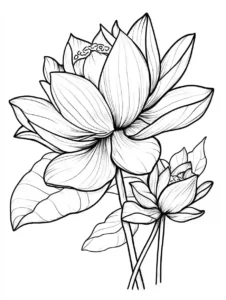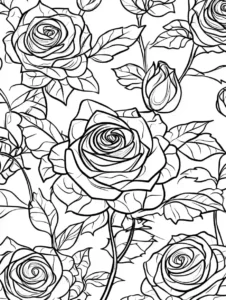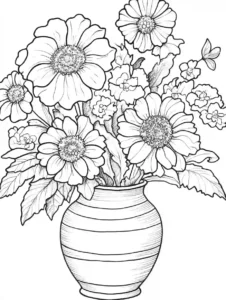Flower Coloring Pages
Flower coloring pages offer a delightful way to express creativity and appreciate the beauty of nature. With a wide range of designs, from intricate mandalas and detailed botanical illustrations to simple outlines of various flower types, these pages cater to artists of all ages and skill levels. Coloring flowers can be a calming and therapeutic activity, allowing individuals to relax and unwind while bringing vibrant colors to life. Whether you’re working on a specific project, decorating a room, or simply enjoying a quiet afternoon, flower coloring pages provide an enjoyable way to explore floral patterns, enhance fine motor skills, and cultivate an appreciation for the diverse colors and shapes found in nature. Grab your coloring tools and let your imagination bloom!
Here are some fun facts about flowers:
Diversity: There are over 400,000 known species of flowering plants (angiosperms) worldwide, each with its unique shape, color, and scent. This incredible diversity allows for a wide range of ecosystems and habitats.
Pollination Partners: Many flowers rely on specific pollinators, such as bees, butterflies, and birds, to reproduce. The shape and color of a flower often evolve to attract particular pollinators, ensuring successful fertilization.
Colors and Meaning: Flowers have been assigned meanings throughout history. For example, red roses symbolize love, while yellow roses are associated with friendship. This practice, known as floriography, was particularly popular in Victorian times.
Oldest Flower: The oldest known flowering plant is Archaefructis. Fossils of this plant have been dated to around 125 million years ago, providing insight into the early evolution of flowering plants.
Scent Production: Flowers produce various scents to attract pollinators. These scents are often created by volatile organic compounds (VOCs) and can vary significantly between species. Some flowers are even known to mimic the scents of other flowers to attract specific pollinators.
Flowers and Food: Many flowers are edible and can be used in cooking or as garnishes. Common edible flowers include nasturtiums, pansies, and hibiscus, which can add flavor and color to dishes.
Medicinal Uses: Throughout history, various flowers have been used in traditional medicine for their healing properties. For example, chamomile flowers are known for their calming effects, while calendula is often used for skin healing.
Flower Lifespan: The lifespan of flowers varies greatly depending on the species. Some flowers, like dandelions, can bloom and die within a few weeks, while others, like orchids, can bloom for several months.
Symbol of Rebirth: In many cultures, flowers symbolize rebirth and renewal, particularly in spring when many plants bloom after winter dormancy. Cherry blossoms, for example, are celebrated in Japan for their fleeting beauty and represent the transient nature of life.
Flower Anatomy: A typical flower has four main parts: petals, sepals, stamens (male reproductive parts), and carpels (female reproductive parts). The arrangement and structure of these parts can vary widely among different flower species.
These fun facts highlight the beauty, diversity, and significance of flowers in nature and human culture!










